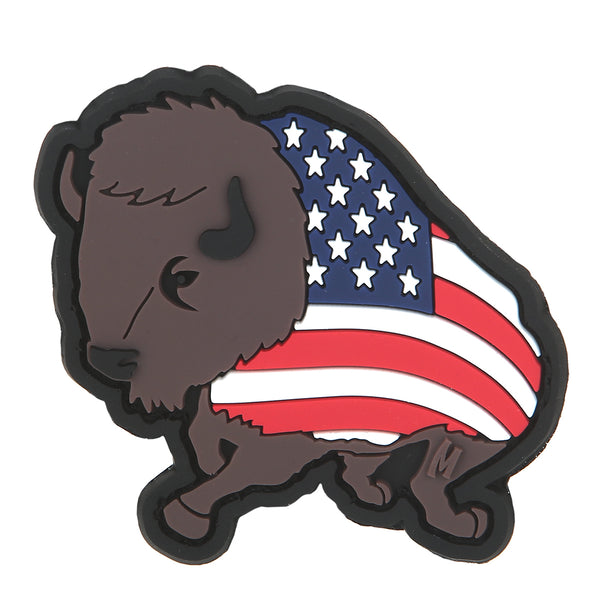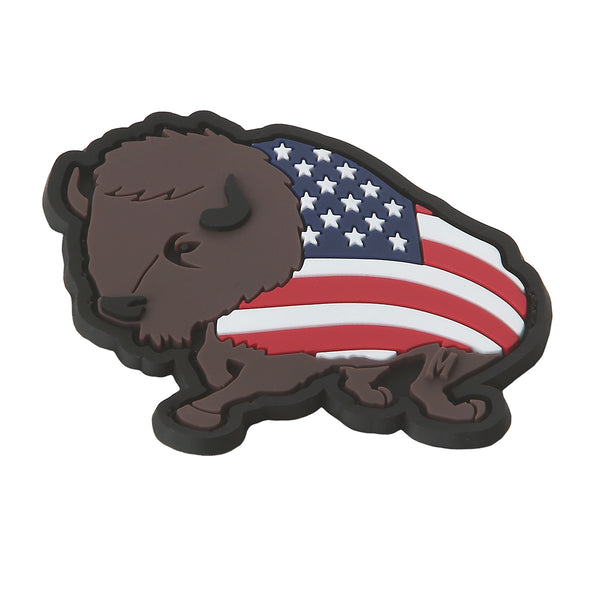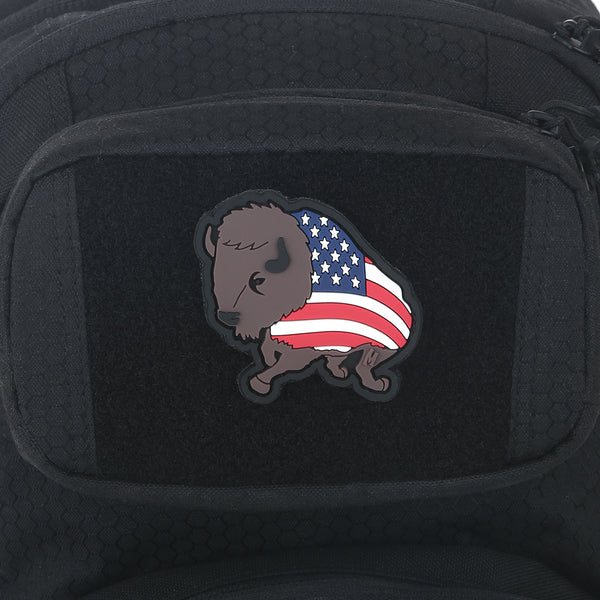Description
The American Bison is a symbol of strength, freedom and abundance. Stars & stripes superimposed over its torso add a patriotic flare.
The national mammal of the United States is a force to be reckoned with. Weighing up to 2,000 lbs (907 kg), the American Bison has a top speed of 35 mph (56 km/h) and is extremely agile – able to spin around quickly and jump high fences. Respect this massive animal and keep your distance, or be ready for its wrath.
Overall size
- 3.25"(L) x 2.5"(H)
- Made from PVC rubber
- Includes additional loop field lined sheet for sewing onto clothes or protecting hook back when not in use
MAXPEDITION® MORALE PATCHES
Identify & Personalize Your Gear
Maxpedition brings you a new collection of morale patches you'll never see anywhere else, featuring original artwork and unique designs for the true individual. Built to personalize, these patches have a hook back to attach to the loop lining of your Maxpedition bag, and can be stitched on to your gear without having to tear or damage their backing. Add flair and say it loud with Maxpedition morale patches.
Article "Bison Bellows: America's New National Mammal" from the National Park Service website, NPS.gov
URL: https://www.nps.gov/articles/bison-bellows-5-12-16.htm
"Joining the bald eagle as a national symbol, the American bison recently became the United States' first national mammal. After four years of outreach to Congress and the White House, by the Wildlife Conservation Society, its partners the InterTribal Buffalo Council and National Bison Association and 60-plus Vote Bison Coalition members, the National Bison Legacy Act was signed on May 9, 2016, officially making the bison our national mammal. This historic event represents a true comeback story, embedded with history, culture, and conservation.
Less than 100 years ago, the American bison was teetering on the verge of extinction. By the beginning of the 20th century, the species' numbers fell from herds of roughly 40 million to less than 1,000 individuals. The impact on Native Americans was devastating.
In 1905, William Hornaday, Theodore Roosevelt, and others formed the American Bison Society (ABS) to help save bison from extinction---the first national effort to save an American wildlife species. The U.S. Department of Interior (DOI) also helped reverse the bison's fate. Beginning at Yellowstone National Park in 1872, the park protected its remaining two dozen bison. Today, through immense collaboration with diverse partners, DOI lands currently support 17 bison herds in 12 states, for a total of approximately 10,000 bison over 4.6 million acres of DOI and adjacent lands.
To honor such an iconic and resilient species, Congress passed the National Bison Legacy Act on April 28, 2016, making the bison a U.S. symbol of unity, resilience and healthy landscapes and communities. The Act recognizes the historical, cultural, and economic importance of bison. More than 60 American Indian tribes participate in the Intertribal Buffalo Council, an organization working to help coordinate and assist tribes in returning bison back to tribal lands. Also, over one million acres of tribal land contribute to the conservation and cultural efforts of bison. Not only do bison play an important cultural role, but they also have significant economic value. Private bison producers own about 360,000 bison, creating jobs and providing a healthy meat source as well as leather and wool products to the American public. Bison also play an important ecological role, beneficially influencing prairie ecosystems through their grazing patters and behavior.
Although the recognition does not convey new protections for the bison, the Act recognizes the great conservation success story and importance of its comeback to Native Americans and rural communities alike. This new and permanent designation conveys a vision of shared values of unity, resilience and healthy landscapes and communities. No other species is so iconic of American history and culture like the bison."
***********
Article "15 Facts About Bison" from the National Park Service website, NPS.gov
URL: https://www.nps.gov/articles/15-facts-about-bison.htm
On May 9, 2016, President Obama signed the National Bison Legacy Act into law, officially making the American bison the national mammal of the United States. This majestic animal joins the ranks of the bald eagle as the official symbol of our country—and much like the eagle, it's one of the greatest conservation success stories of all time.
In prehistoric times, millions of bison roamed North America—from the forests of Alaska and the grasslands of Mexico to Nevada’s Great Basin and the eastern Appalachian Mountains. But by the late 1800s, there were only a few hundred bison left in the United States after European settlers pushed west, reducing the animal’s habitat and hunting the bison to near extinction. Had it not been for a few private individuals working with tribes, states and the Interior Department, the bison would be extinct today.
Explore more fun facts about the American bison:
1. Bison are the largest mammal in North America. Male bison (called bulls) weigh up to 2,000 pounds and stand 6 feet tall, while females (called cows) weigh up to 1,000 pounds and reach a height of 4-5 feet. Bison calves weigh 30–70 pounds at birth.
2. Since the late 19th century, [the Department of the] Interior has been the primary national conservation steward of the bison. Public lands managed by Interior support 17 bison herds—or approximately 10,000 bison—in 12 states, including Alaska.
3. What’s the difference between bison and buffalo? While bison and buffalo are used interchangeably, in North America the scientific name is bison. Actually, it's Bison bison bison (genus: Bison, species: bison, subspecies: bison), but only saying it once is fine. Historians believe that the term "buffalo" grew from the French word for beef, "boeuf."
4.Yellowstone National Park is the only place in the U.S. where bison have continuously lived since prehistoric times. What makes Yellowstone's bison so special is that they're the pure descendants (free of cattle genes) of early bison that roamed our country's grasslands. As of July 2015, Yellowstone's bison population was estimated at 4,900—making it the largest bison population on public lands.
5. What's a "red dog"? It's a baby bison. Bison calves tend to be born from late March through May and are orange-red in color, earning them the nickname "red dogs." After a few months, their hair starts to change to dark brown and their characteristic shoulder hump and horns begin to grow.
6. The history of bison and Native Americans are intertwined. Bison have been integral to tribal culture, providing them with food, clothing, fuel, tools, shelter and spiritual value. Established in 1992, the Inter Tribal Buffalo Council works with the National Park Service to transfer bison from national park lands to tribal lands.
7. You can judge a bison's mood by its tail. When it hangs down and switches naturally, the bison is usually calm. If the tail is standing straight up, watch out! It may be ready to charge. No matter what a bison's tail is doing, remember that they are unpredictable and can charge at any moment. Every year, there are regrettable accidents caused by people getting too close to these massive animals. It's great to love the bison, but love them from a distance.
8. Wind Cave National Park's herd helped revive bison populations around the country. The story starts in 1905 with the formation of the American Bison Society and a breeding program at the New York City Zoo (today, the Bronx Zoo). By 1913, the American Bison Society had enough bison to restore a free-ranging bison herd. Working with Interior, they donated 14 bison to Wind Cave National Park in South Dakota. More than 100 years later, the bison from Wind Cave have helped reestablishing other herds across the United States and most recently in Mexico.
9. Bison may be big, but they're also fast. They can run up to 35 miles per hour. Plus, they're extremely agile. Bison can spin around quickly, jump high fences and are strong swimmers.
10. Pass the salad, please. Bison primarily eat grasses, weeds and leafy plants—typically foraging for 9–11 hours a day. That's where the bison's large protruding shoulder hump comes in handy during the winter. It allows them to swing their heads from side-to-side to clear snow—especially for creating foraging patches.
11. From hunter to conservationist, Teddy Roosevelt helped save bison from extinction. In 1883, Teddy Roosevelt traveled to the Dakota Territory to hunt bison. After spending a few years in the west, Roosevelt returned to New York with a new outlook on life. He paved the way for the conservation movement, and in 1905, formed the American Bison Society with William Hornaday to save the disappearing bison. Today bison live in all 50 states, including Native American lands, wildlife refuges, national parks and private lands.
12. Bison can live up to 20 years old. The average lifespan for a bison is 10–20 years, but some live to be older. Cows begin breeding at the age of 2 and only have one baby at a time. For males, the prime breeding age is 6–10 years.
13. A little dirt won't hurt. Called wallowing, bison roll in the dirt to deter biting flies and help shed fur. Male bison also wallow during mating season to leave behind their scent and display their strength.
14. The American bison's ancestors can be traced to southern Asia thousands of years ago. Bison made their way to America by crossing the ancient land bridge that once connected Asia with North America during the Pliocene Epoch, some 400,000 years ago. These ancient animals were much larger than the iconic bison we love today. Fossil records show that one prehistoric bison, Bison latiforns, had horns measuring 9 feet from tip to tip.
15. Bison are nearsighted—who knew? While bison have poor eyesight, they have excellent senses of smell and hearing. Cows and calves communicate using pig-like grunts, and during mating season, bulls can be heard bellowing across long distances.










